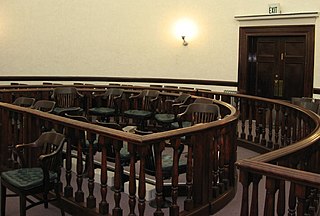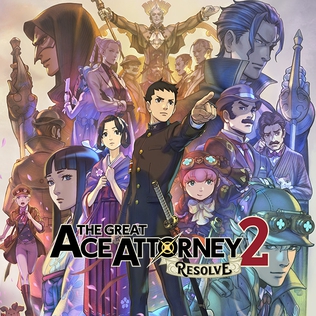
A jury is a sworn body of people (jurors) convened to hear evidence, make findings of fact, and render an impartial verdict officially submitted to them by a court, or to set a penalty or judgment.

Legal drama is a genre of film and television that generally focuses on narratives regarding legal practice and the justice system. The American Film Institute (AFI) defines "courtroom drama" as a genre of film in which a system of justice plays a critical role in the film's narrative. Legal dramas have also followed the lives of the fictional attorneys, defendants, plaintiffs, or other persons related to the practice of law present in television show or film. Legal drama is distinct from police crime drama or detective fiction, which typically focus on police officers or detectives investigating and solving crimes. The focal point of legal dramas, more often, are events occurring within a courtroom, but may include any phases of legal procedure, such as jury deliberations or work done at law firms. Some legal dramas fictionalize real cases that have been litigated, such as the play-turned-movie, Inherit the Wind, which fictionalized the Scopes Monkey Trial. As a genre, the term "legal drama" is typically applied to television shows and films, whereas legal thrillers typically refer to novels and plays.
Voir dire is a legal term for procedures during a trial that help a judge decide certain issues:

The Runaway Jury is a legal thriller novel written by American author John Grisham. It was Grisham's seventh novel. The hardcover first edition was published by Doubleday Books in 1996 (ISBN 0-385-47294-3). Pearson Longman released the graded reader edition in 2001 (ISBN 0-582-43405-X). The novel was published again in 2003 to coincide with the release of Runaway Jury, a movie adaptation of the novel starring Gene Hackman, Dustin Hoffman, John Cusack and Rachel Weisz. The third printing (ISBN 0-440-22147-1) bears a movie-themed cover, in place of the covers used on the first and second printings.

Runaway Jury is a 2003 American legal thriller film directed by Gary Fleder and starring John Cusack, Gene Hackman, Dustin Hoffman and Rachel Weisz. An adaptation of John Grisham's 1996 novel The Runaway Jury, the film pits lawyer Wendell Rohr (Hoffman) against shady jury consultant Rankin Fitch (Hackman), who uses unlawful means to stack the jury with people sympathetic to the defense. Meanwhile, a high-stakes cat-and-mouse game begins when juror Nicholas Easter (Cusack) and his girlfriend Marlee (Weisz) appear to be able to sway the jury to deliver any verdict they want in a trial against a gun manufacturer. The film was released October 17, 2003.

Twilight of Honor, released in the UK as The Charge is Murder, is a 1963 American neo noir crime film directed by Boris Sagal and starring Richard Chamberlain, Nick Adams, Claude Rains, and featuring Joey Heatherton and Linda Evans in their film debuts. Twilight of Honor is a courtroom drama based on Al Dewlen's novel, with a screenplay by Henry Denker. Like the 1959 courtroom drama Anatomy of a Murder, it continued a recent trend of descriptions of things previously never mentioned in American cinema, such as vivid accounts of sexual assault, adultery, and prostitution.

The CSI effect describes the various ways in which the exaggerated portrayal of forensic science on crime television shows such as CSI: Crime Scene Investigation influences public perception. The term was first reported in a 2004 USA Today article describing the effect being made on trial jurors by television programs featuring forensic science.
Jury selection is the selection of the people who will serve on a jury during a jury trial. The group of potential jurors is first selected from among the community using a reasonably random method. Jury lists are compiled from voter registrations and driver license or ID renewals. From those lists, summonses are mailed. A panel of jurors is then assigned to a courtroom.

Earl Rogers was an American trial lawyer and professor. Rogers became the inspiration for Erle Stanley Gardner's fictional character Perry Mason. He was also posthumously inducted into the Trial Lawyer Hall of Fame.
Jury or juror research is an umbrella term for the use of research methods in an attempt to gain some understanding of the juror experience in the courtroom and how jurors individually and collectively come to a determination about the guilt or otherwise of the accused.

The Just and the Unjust is a novel by James Gould Cozzens published in 1942. Set in "Childerstown," a fictional rural town of 4000 persons, the novel is a courtroom drama of a murder trial that begins June 14, 1939, and takes three days.
Scientific jury selection, often abbreviated SJS, is the use of social science techniques and expertise to choose favorable juries during a criminal or civil trial. Scientific jury selection is used during the jury selection phase of the trial, during which lawyers have the opportunity to question jurors. It almost always entails an expert's assistance in the attorney's use of peremptory challenges—the right to reject a certain number of potential jurors without stating a reason—during jury selection. The practice is currently unique to the American legal system.

The court of assizes is the trial court which tries the most serious crimes in the judicial system of Belgium. It is the highest Belgian court with criminal jurisdiction; as such, it is the only Belgian court that can sentence someone to life imprisonment. The courts of assizes are not permanent courts; a new court of assizes is assembled for each new trial. There is a court of assizes in each of the ten provinces of Belgium, as well as one in the arrondissement of Brussels-Capital which is not part of any province. Further below, an overview is provided of the eleven courts of assizes and their seats. They are the only courts in Belgium for which the provinces are used as territorial subdivisions. They are also the only courts in Belgium that hold jury trials. The jury acts as sole trier of fact, but decides on the penalty together with the judges. The trial by jury of certain crimes is laid down in article 150 of the Belgian Constitution. The Belgian courts of assizes have the same origin as their French namesakes.
Rice v. Collins, 546 U.S. 333 (2006), was a decision by the Supreme Court of the United States regarding a prosecutor's use of a peremptory challenge to remove a young African American woman, Juror 16, from a defendant's drug trial jury in a California court case, based on her youth and on her alleged "eye rolling" in answer to a question. The defendant, Steven Martell Collins, challenged the striking of Juror 16, saying her exclusion was based on race, but the trial judge agreed that the prosecutor's reasons were race-neutral. The California Court of Appeal upheld the trial court's ruling, and the Federal District Court dismissed Collins' habeas corpus petition with prejudice. However, the Ninth Circuit Court of Appeals reversed and remanded, stating that the dismissal was unreasonable based, among other reasons, on the lack of evidence that the eye rolling had occurred.
Trial films is a subgenre of the legal/courtroom drama that encompasses films that are centered on a civil or criminal trial, typically a trial by jury.
Jury selection in the United States is the choosing of members of grand juries and petit juries for the purpose of conducting trial by jury in the United States.

Courtroom photographing, videotaping and broadcasting is restricted in many jurisdictions. The law varies from limited film and electronic media coverage in some countries, to a complete ban in others.
A political defense is a defense to a criminal charge in which the defendant asserts at trial the political motivations behind the allegedly criminal conduct. In some circumstances, the defendant might assert political motivations in order to seek acquittal. In other circumstances, defendants might not have a realistic hope of acquittal but may nevertheless use the trial as a forum for expressing political views.

Enemies & Allies is a 2009 novel by American science fiction author Kevin J. Anderson. The book is set in the 1950s, in the midst of the Cold War, and follows Superman and Batman. Though suspicious of each other, they confront Lex Luthor who stages an international nuclear conflict and spreads fear of an alien invasion so that he can sell advanced weapons to governments. Themes used in the novel, reflective of the 1950s era, include alien invasion films, nuclear threats, and Cold War paranoia.

The Great Ace Attorney 2: Resolve is an adventure game in the Ace Attorney series and the sequel to The Great Ace Attorney: Adventures, developed and published by Capcom. It was directed by Shu Takumi and produced by Motohide Eshiro. The game was released for the Nintendo 3DS in Japan in August 2017, with Android and iOS versions following in April 2018. Resolve was released worldwide in July 2021 via The Great Ace Attorney Chronicles, a duology compilation of both games for Nintendo Switch, PlayStation 4, and Windows.










